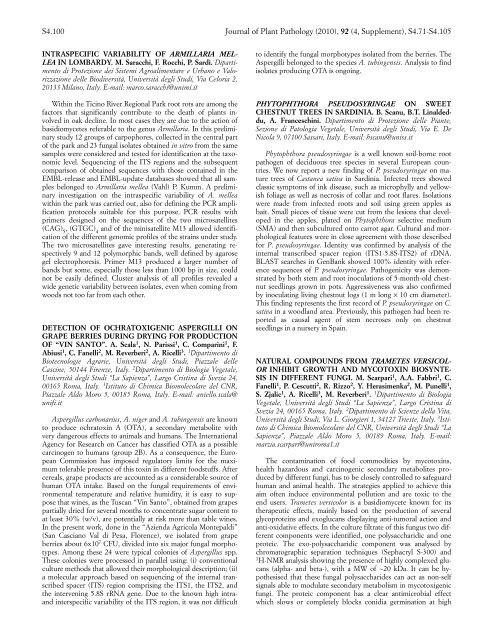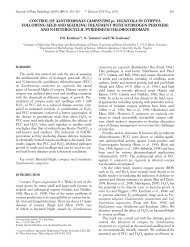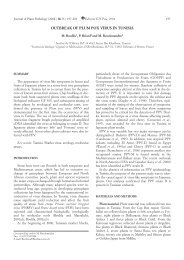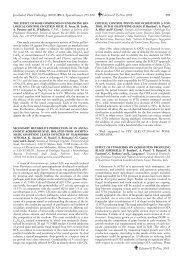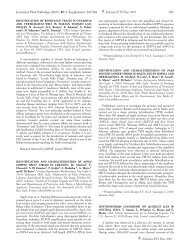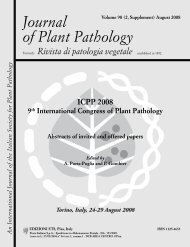Journal of Plant Pathology (2010), 92 (4, Supplement ... - Sipav.org
Journal of Plant Pathology (2010), 92 (4, Supplement ... - Sipav.org
Journal of Plant Pathology (2010), 92 (4, Supplement ... - Sipav.org
You also want an ePaper? Increase the reach of your titles
YUMPU automatically turns print PDFs into web optimized ePapers that Google loves.
S4.100 <strong>Journal</strong> <strong>of</strong> <strong>Plant</strong> <strong>Pathology</strong> (<strong>2010</strong>), <strong>92</strong> (4, <strong>Supplement</strong>), S4.71-S4.105<br />
INTRASPECIFIC VARIABILITY OF ARMILLARIA MEL-<br />
LEA IN LOMBARDY. M. Saracchi, F. Rocchi, P. Sardi. Dipartimento<br />
di Protezione dei Sistemi Agroalimentare e Urbano e Valorizzazione<br />
delle Biodiversità, Università degli Studi, Via Celoria 2,<br />
20133 Milano, Italy. E-mail: marco.saracchi@unimi.it<br />
Within the Ticino River Regional Park root rots are among the<br />
factors that significantly contribute to the death <strong>of</strong> plants involved<br />
in oak decline. In most cases they are due to the action <strong>of</strong><br />
basidiomycetes referable to the genus Armillaria. In this preliminary<br />
study 12 groups <strong>of</strong> carpophores, collected in the central part<br />
<strong>of</strong> the park and 23 fungal isolates obtained in vitro from the same<br />
samples were considered and tested for identification at the taxonomic<br />
level. Sequencing <strong>of</strong> the ITS regions and the subsequent<br />
comparison <strong>of</strong> obtained sequences with those contained in the<br />
EMBL-release and EMBL-update databases showed that all samples<br />
belonged to Armillaria mellea (Vahl) P. Kumm. A preliminary<br />
investigation on the intraspecific variability <strong>of</strong> A. mellea<br />
within the park was carried out, also for defining the PCR amplification<br />
protocols suitable for this purpose. PCR results with<br />
primers designed on the sequences <strong>of</strong> the two microsatellites<br />
(CAG) 5 , (GTGC) 4 and <strong>of</strong> the minisatellite M13 allowed identification<br />
<strong>of</strong> the different genomic pr<strong>of</strong>iles <strong>of</strong> the strains under study.<br />
The two microsatellites gave interesting results, generating respectively<br />
9 and 12 polymorphic bands, well defined by agarose<br />
gel electrophoresis. Primer M13 produced a larger number <strong>of</strong><br />
bands but some, especially those less than 1000 bp in size, could<br />
not be easily defined. Cluster analysis <strong>of</strong> all pr<strong>of</strong>iles revealed a<br />
wide genetic variability between isolates, even when coming from<br />
woods not too far from each other.<br />
DETECTION OF OCHRATOXIGENIC ASPERGILLI ON<br />
GRAPE BERRIES DURING DRYING FOR PRODUCTION<br />
OF “VIN SANTO”. A. Scala 1 , N. Parissi 1 , C. Comparini 1 , F.<br />
Abiusi 1 , C. Fanelli 2 , M. Reverberi 2 , A. Ricelli 3 . 1 Dipartimento di<br />
Biotecnologie Agrarie, Università degli Studi, Piazzale delle<br />
Cascine, 50144 Firenze, Italy. 2 Dipartimento di Biologia Vegetale,<br />
Università degli Studi “La Sapienza”, Largo Cristina di Svezia 24,<br />
00165 Roma, Italy. 3 Istituto di Chimica Biomolecolare del CNR,<br />
Piazzale Aldo Moro 5, 00185 Roma, Italy. E-mail: aniello.scala@<br />
unifi.it<br />
Aspergillus carbonarius, A. niger and A. tubingensis are known<br />
to produce ochratoxin A (OTA), a secondary metabolite with<br />
very dangerous effects to animals and humans. The International<br />
Agency for Research on Cancer has classified OTA as a possible<br />
carcinogen to humans (group 2B). As a consequence, the European<br />
Commission has imposed regulatory limits for the maximum<br />
tolerable presence <strong>of</strong> this toxin in different foodstuffs. After<br />
cereals, grape products are accounted as a considerable source <strong>of</strong><br />
human OTA intake. Based on the fungal requirements <strong>of</strong> environmental<br />
temperature and relative humidity, it is easy to suppose<br />
that wines, as the Tuscan “Vin Santo”, obtained from grapes<br />
partially dried for several months to concentrate sugar content to<br />
at least 30% (w/v), are potentially at risk more than table wines.<br />
In the present work, done in the “Azienda Agricola Montepaldi”<br />
(San Casciano Val di Pesa, Florence), we isolated from grape<br />
berries about 6x10 7 CFU, divided into six major fungal morphotypes.<br />
Among these 24 were typical colonies <strong>of</strong> Aspergillus spp.<br />
These colonies were processed in parallel using: (i) conventional<br />
culture methods that allowed their morphological description; (ii)<br />
a molecular approach based on sequencing <strong>of</strong> the internal transcribed<br />
spacer (ITS) region comprising the ITS1, the ITS2, and<br />
the intervening 5.8S rRNA gene. Due to the known high intraand<br />
interspecific variability <strong>of</strong> the ITS region, it was not difficult<br />
to identify the fungal morphotypes isolated from the berries. The<br />
Aspergilli belonged to the species A. tubingensis. Analysis to find<br />
isolates producing OTA is ongoing.<br />
PHYTOPHTHORA PSEUDOSYRINGAE ON SWEET<br />
CHESTNUT TREES IN SARDINIA. B. Scanu, B.T. Linaldeddu,<br />
A. Franceschini. Dipartimento di Protezione delle Piante,<br />
Sezione di Patologia Vegetale, Università degli Studi, Via E. De<br />
Nicola 9, 07100 Sassari, Italy. E-mail: bscanu@uniss.it<br />
Phytophthora pseudosyringae is a well known soil-borne root<br />
pathogen <strong>of</strong> deciduous tree species in several European countries.<br />
We now report a new finding <strong>of</strong> P. pseudosyringae on mature<br />
trees <strong>of</strong> Castanea sativa in Sardinia. Infected trees showed<br />
classic symptoms <strong>of</strong> ink disease, such as microphylly and yellowish<br />
foliage as well as necrosis <strong>of</strong> collar and root flares. Isolations<br />
were made from infected roots and soil using green apples as<br />
bait. Small pieces <strong>of</strong> tissue were cut from the lesions that developed<br />
in the apples, plated on Phytophthora selective medium<br />
(SMA) and then subcultured onto carrot agar. Cultural and morphological<br />
features were in close agreement with those described<br />
for P. pseudosyringae. Identity was confirmed by analysis <strong>of</strong> the<br />
internal transcribed spacer region (ITS1-5.8S-ITS2) <strong>of</strong> rDNA.<br />
BLAST searches in GenBank showed 100% identity with reference<br />
sequences <strong>of</strong> P. pseudosyringae. Pathogenicity was demonstrated<br />
by both stem and root inoculations <strong>of</strong> 5-month-old chestnut<br />
seedlings grown in pots. Aggressiveness was also confirmed<br />
by inoculating living chestnut logs (1 m long × 10 cm diameter).<br />
This finding represents the first record <strong>of</strong> P. pseudosyringae on C.<br />
sativa in a woodland area. Previously, this pathogen had been reported<br />
as causal agent <strong>of</strong> stem necroses only on chestnut<br />
seedlings in a nursery in Spain.<br />
NATURAL COMPOUNDS FROM TRAMETES VERSICOL-<br />
OR INHIBIT GROWTH AND MYCOTOXIN BIOSYNTE-<br />
SIS IN DIFFERENT FUNGI. M. Scarpari 1 , A.A. Fabbri 1 , C.<br />
Fanelli 1 , P. Cescutti 2 , R. Rizzo 2 , Y. Herasimenka 2 , M. Punelli 1 ,<br />
S. Zjalic 1 , A. Ricelli 3 , M. Reverberi 1 . 1 Dipartimento di Biologia<br />
Vegetale, Università degli Studi “La Sapienza”, Largo Cristina di<br />
Svezia 24, 00165 Roma, Italy. 2 Dipartimento di Scienze della Vita,<br />
Università degli Studi, Via L. Gi<strong>org</strong>ieri 1, 34127 Trieste, Italy. 3 Istituto<br />
di Chimica Biomolecolare del CNR, Università degli Studi “La<br />
Sapienza”, Piazzale Aldo Moro 5, 00189 Roma, Italy. E-mail:<br />
marzia.scarpari@uniroma1.it<br />
The contamination <strong>of</strong> food commodities by mycotoxins,<br />
health hazardous and carcinogenic secondary metabolites produced<br />
by different fungi, has to be closely controlled to safeguard<br />
human and animal health. The strategies applied to achieve this<br />
aim <strong>of</strong>ten induce environmental pollution and are toxic to the<br />
end users. Trametes versicolor is a basidiomycete known for its<br />
therapeutic effects, mainly based on the production <strong>of</strong> several<br />
glycoproteins and exoglucans displaying anti-tumoral action and<br />
anti-oxidative effects. In the culture filtrate <strong>of</strong> this fungus two different<br />
components were identified, one polysaccharidic and one<br />
proteic. The exo-polysaccharidic component was analysed by<br />
chromatographic separation techniques (Sephacryl S-300) and<br />
1 H-NMR analysis showing the presence <strong>of</strong> highly complexed glucans<br />
(alpha- and beta-), with a MW <strong>of</strong> ~20 kDa. It can be hypothesised<br />
that these fungal polysaccharides can act as non-self<br />
signals able to modulate secondary metabolism in mycotoxigenic<br />
fungi. The proteic component has a clear antimicrobial effect<br />
which slows or completely blocks conidia germination at high


